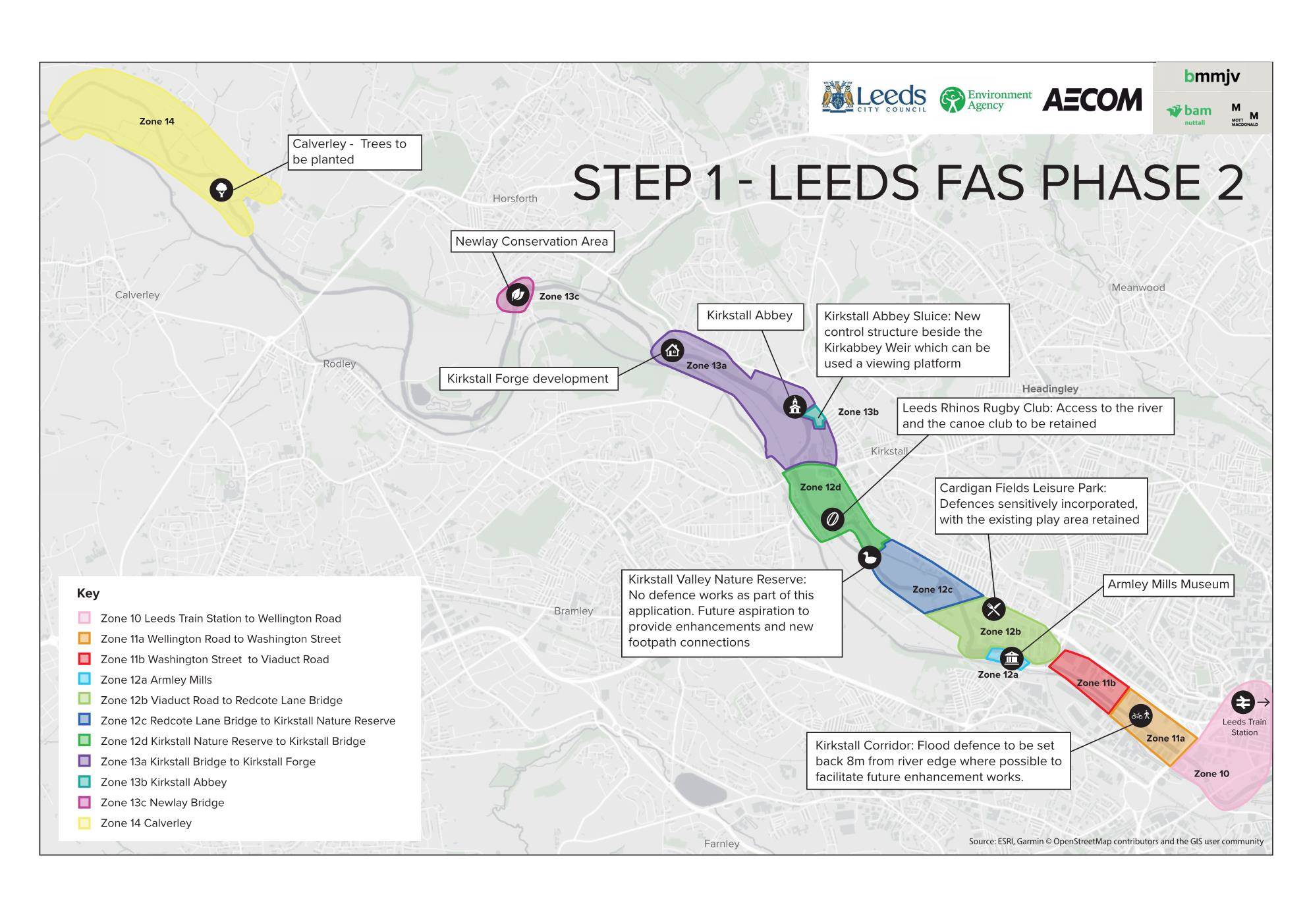Work starts on next phase of Leeds Flood Alleviation Scheme to protect hundreds of businesses and homes
The project received a £3.9 million investment from the Leeds City Region Growth Deal
22 January 2020
Work has started on the next stage of a major scheme to reduce the risk of flooding in Leeds.
Construction on the second phase of the Leeds Flood Alleviation Scheme will see flood defences being built on the River Aire upstream of Leeds Station as part of a catchment-wide approach to reducing flood risk.
The £112 million scheme, which is being led by Leeds City Council and the Environment Agency, will improve protection for 1,048 homes and 474 businesses.
It received a £3.9 million investment from the Leeds City Region Growth Deal – a £1 billion plus package of investment between the LEP and the Government to transform the Leeds City Region economy.
The phase two proposals are split into two steps and feature measures such as new defence walls, embankments and a large flood storage area.
The first step of phase two, at a cost of £87 million, will give protection against a one-in-100 chance of flooding in any given year along an 8km stretch upstream of Leeds station including three key areas – Leeds Industrial Museum at Armley Mills, Kirkstall Abbey and Kirkstall Meadows. These works are expected to be complete by winter 2022.
The second stage involves creating flood storage at Calverley, making use of an existing flood plain, and works at Apperley Bridge, which will bring the level of protection up to a one-in-200 chance of flooding in any given year, equivalent to the Boxing Day floods that hit areas such as Kirkstall in December 2015.
Cllr Judith Blake, Leader of Leeds City Council and West Yorkshire Combined Authority Transport Lead, said: “It is very pleasing and heartening to see the next stage of this ambitious scheme to reduce the risk of flooding along the River Aire starting. Seeing work happening on the ground will hopefully give reassurance to the communities, businesses and residents in the Kirkstall Corridor and upstream that soon they will have measures in place to prevent a repeat of the catastrophic damage and pain caused by the impact of Storm Eva.
“This is the first step of a two-step process which we are determined to see completed in full. We continue to call on the government to provide the remaining funding or meet with us to discuss options so we can ensure all communities vulnerable to flooding from the River Aire have the highest possible level of flood defences in place, and our city is as resilient as we can make it to the increasing threat of extreme weather events due to climate change.”

Adrian Gill, Area Flood Risk Manager at the Environment Agency, said: “Our joint project team is delighted to have achieved this significant milestone of starting construction on flood risk alleviation works in an area which was impacted by the floods of December 2015. Our shared ambition is to complete both steps of this second phase of the scheme. This first step will provide much better protection from the River Aire upstream of Leeds station through the Kirkstall area and out to Newlay.
“The natural flood management measures that will be delivered across the catchment upstream as part of the first step will not only help reduce flood risk but also restore and create new habitat, increase biodiversity resilience and improve water quality. This will contribute to delivering the Government’s 25 Year Environment Plan and realising the vision of the Northern Forest in the Aire catchment.”
The Boxing Day floods in 2015 affected 3,355 properties in Leeds, of which 672 were commercial businesses. The direct cost to the city was an estimated £36.8 million, with the cost to the wider city region being more than £500 million.
The phase two work is being split into zones, and detailed designs are currently being worked on for future phases of work up the River Aire corridor.
The project also incorporates a flagship Natural Flood Management (NFM) programme. Natural flood management is when natural processes are used to reduce the risk of flooding. The team is working with partners and landowners across the catchment to deliver a range of measures, such as the creation of new woodland and other natural features. These techniques will hold back water to help reduce the flow of rainwater into the river and help reduce the impacts of climate change.
As part of the river channel maintenance element of the scheme, a small number of trees which have been assessed to be unstable or present a possible flood risk will be trimmed or removed and replaced by newly-planted trees. The removed trees will be recycled as much as possible as part of the scheme, including helping to create new habitat along the river to support wildlife.
Some trees could be removed where it has not been possible to avoid them by changing the design of the flood defence construction works. Three trees will be planted for every tree that is removed, with a preference of re-planting as close as possible. This is in addition to the thousands of trees being planted across the catchment as part of the NFM work.
The work follows completion of the first phase of the Leeds Flood Alleviation Scheme in October 2017 where flood defences were installed along the River Aire in Leeds for the first time.
